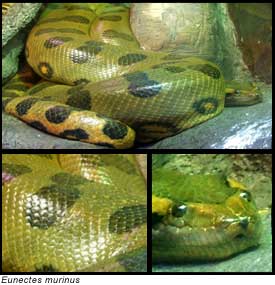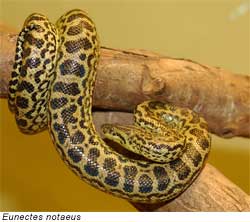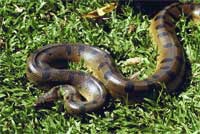|

Body Builder: The Anaconda come equipped with a large head and a thick neck. Its
eyes and nostrils are positioned on the top of the head, enabling
the Anaconda to breathe and to see its prey while its stocky body
lays submerged under water. The extremely muscular Anaconda is a
constrictor and is not venomous; however, it still has teeth and
powerful jaws that it utilizes to clench onto its prey. It grabs
its victim and pulls it underwater, drowning the prey.

 Specific Diets: They typically feed on large rodents, tapirs, capybaras, deer, peccaries,
fish, turtles, birds, sheep, dogs and aquatic reptiles like caiman.
They have been known to occasionally prey on jaguars and attacks
on humans can be confirmed, although this is rare. Younger Anacondas
feed on mice, rats, chicks, frogs and fish. Most local people kill
these snakes on sight, out of the fear that they are man-eaters.
In most instances, if an Anaconda senses humans in the area, it
will retreat in another direction. Human death by Anaconda is quite
rare. Specific Diets: They typically feed on large rodents, tapirs, capybaras, deer, peccaries,
fish, turtles, birds, sheep, dogs and aquatic reptiles like caiman.
They have been known to occasionally prey on jaguars and attacks
on humans can be confirmed, although this is rare. Younger Anacondas
feed on mice, rats, chicks, frogs and fish. Most local people kill
these snakes on sight, out of the fear that they are man-eaters.
In most instances, if an Anaconda senses humans in the area, it
will retreat in another direction. Human death by Anaconda is quite
rare.
Surprise Attack: Anacondas are usually coiled up in a murky, shallow pool or at
the river's edge. They wait to ambush their unsuspecting prey when
they come down for a drink. Anacondas bite their prey with their
sharp teeth, hold on with their powerful jaws and pull them under
water. The victim may drown first or it may be squeezed to death
in the Anaconda's muscular coils. Anacondas, true to the Boa family,
constrict their hapless victims to death. The snake squeezes tighter
each time its prey breathes out, so the prey cannot breath in again.
Suffocation does not take long. Anacondas swallow their prey whole,
starting with the head. This is so the legs fold up and the prey
goes down smoothly. The Anaconda can swallow prey much bigger than
the size of its mouth since its jaw can unhinge and the jaw bones
are loosely connected to the skull. While the snake eats, its muscles
have wave-like contractions, crushing the prey even further and
surging it downward with each bite.
 Need some dental work?: Just about every species of snake on earth has teeth, but the anacondas'
teeth are not used for chewing. Most snakes' teeth are used for
holding onto their prey, preventing them from escaping. Some snakes
have venom in two specially designed, extra long teeth which they
use to kill their prey. Anacondas have teeth, but they are not a
venomous snake. They rely on their enormous size and power to subdue
their victims. It is possible to be bitten by an anaconda, but the
bite itself would not be fatal. Need some dental work?: Just about every species of snake on earth has teeth, but the anacondas'
teeth are not used for chewing. Most snakes' teeth are used for
holding onto their prey, preventing them from escaping. Some snakes
have venom in two specially designed, extra long teeth which they
use to kill their prey. Anacondas have teeth, but they are not a
venomous snake. They rely on their enormous size and power to subdue
their victims. It is possible to be bitten by an anaconda, but the
bite itself would not be fatal.
Growth Spurts: An Anaconda, like all large species Boas and Pythons, continue
to grow throughout their lives. Their growth speed reduces after
reaching maturity but these snakes possibly reach 50 or 60 years
of age, some maybe 80.

Like almost all boas, Anacondas give birth to live young.
 Giant Anaconda: There are some historical reports of early European explorers of
the South American jungles seeing giant anacondas up to 100 feet
long and some of the native peoples of the South American jungle
have reported seeing anacondas up to 50 feet long. No one has
caught and measured an Anaconda anywhere near that size. Additionally,
it is important to note that there is nothing in their natural habitat
that could satisfy the feeding requirements of an Anaconda that
size. Giant Anaconda: There are some historical reports of early European explorers of
the South American jungles seeing giant anacondas up to 100 feet
long and some of the native peoples of the South American jungle
have reported seeing anacondas up to 50 feet long. No one has
caught and measured an Anaconda anywhere near that size. Additionally,
it is important to note that there is nothing in their natural habitat
that could satisfy the feeding requirements of an Anaconda that
size.
Excess Wieght Loss: When it sheds, an adult anaconda relieves itself of an average
of 2 pounds of skin. An anaconda's skin can stretch up to 30% larger
than the original size of the snake.
All text is available under the terms
of the GNU Free Documentation License
|